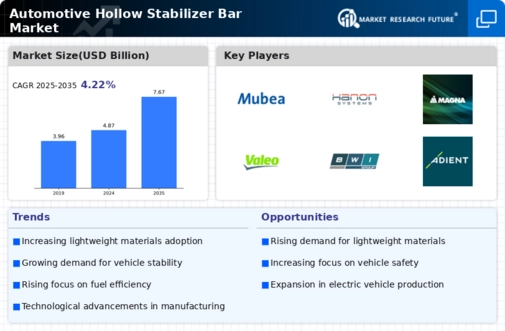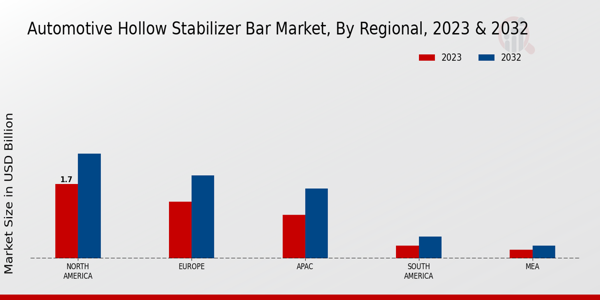Market Growth Projections
The Global Automotive Hollow Stabilizer Bar Market Industry is projected to experience robust growth in the coming years. The market is expected to reach 4.87 USD Billion by 2024 and is anticipated to grow to 7.67 USD Billion by 2035. This growth trajectory indicates a compound annual growth rate (CAGR) of 4.22% from 2025 to 2035. Such projections highlight the increasing importance of hollow stabilizer bars in the automotive sector, driven by factors such as technological advancements, regulatory pressures, and rising consumer expectations. The market's expansion reflects the ongoing evolution of the automotive industry towards enhanced performance and safety.
Growing Automotive Production and Sales
The Global Automotive Hollow Stabilizer Bar Market Industry is significantly influenced by the growing automotive production and sales worldwide. As global vehicle production continues to rise, driven by increasing consumer demand and expanding markets in regions such as Asia-Pacific and North America, the need for high-performance stabilizer bars becomes more pronounced. The automotive sector's recovery and growth are expected to propel the market towards an estimated value of 7.67 USD Billion by 2035. This upward trend underscores the critical role of stabilizer bars in enhancing vehicle stability and safety, thereby driving their adoption across various vehicle segments.
Increasing Demand for Lightweight Materials
The Global Automotive Hollow Stabilizer Bar Market Industry is experiencing a surge in demand for lightweight materials, driven by the automotive sector's focus on enhancing fuel efficiency and reducing emissions. Manufacturers are increasingly adopting hollow stabilizer bars made from advanced materials such as aluminum and high-strength steel. This shift not only contributes to weight reduction but also improves vehicle handling and performance. As a result, the market is projected to reach 4.87 USD Billion in 2024, reflecting a growing preference for innovative solutions that align with sustainability goals. The emphasis on lightweight components is likely to continue shaping the industry landscape.
Regulatory Pressure for Enhanced Vehicle Safety
Regulatory pressure for enhanced vehicle safety is a key driver in the Global Automotive Hollow Stabilizer Bar Market Industry. Governments worldwide are implementing stringent safety regulations that necessitate the incorporation of advanced safety features in vehicles. Hollow stabilizer bars play a crucial role in improving vehicle stability and reducing body roll during cornering, thereby enhancing overall safety. As manufacturers strive to comply with these regulations, the demand for high-quality stabilizer bars is expected to rise. This trend not only supports the market's growth but also encourages innovation in design and materials, ensuring that vehicles meet evolving safety standards.
Rising Consumer Awareness of Vehicle Performance
Rising consumer awareness of vehicle performance is increasingly influencing the Global Automotive Hollow Stabilizer Bar Market Industry. As consumers become more knowledgeable about the impact of vehicle components on handling and ride quality, there is a growing preference for vehicles equipped with advanced stabilizer systems. This shift is prompting manufacturers to invest in research and development to create innovative hollow stabilizer bars that enhance driving dynamics. The heightened focus on performance is likely to drive market growth, as consumers seek vehicles that offer superior handling and comfort, ultimately contributing to the industry's expansion.
Technological Advancements in Manufacturing Processes
Technological advancements in manufacturing processes are playing a pivotal role in the Global Automotive Hollow Stabilizer Bar Market Industry. Innovations such as precision forging and advanced welding techniques enable manufacturers to produce high-quality stabilizer bars with enhanced durability and performance. These advancements not only improve product reliability but also reduce production costs, making hollow stabilizer bars more accessible to a broader range of automotive manufacturers. As the industry evolves, the integration of smart manufacturing technologies is expected to further streamline production processes, potentially increasing market competitiveness and contributing to the projected CAGR of 4.22% from 2025 to 2035.













